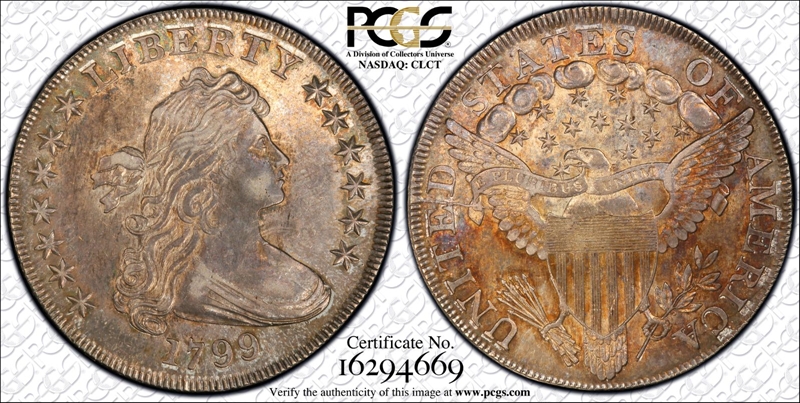1799 $1 BB-154 AU55 认证号16294669, PCGS号40046
拥有者评论
BB-18,BB-154. Was NGC58 but downgraded by PCGS to AU 55 (CAC). I love the color and feel the coin in even unc. Great eye appeal and toning. Slightly weak on reverse but hey after looking at enough varieties you realize this is fairly common in a deteriorating die as seen on this reverse (BB-154). Anyone for MS62?. R5. Est.Pop.50-75 coins. Rare in high grade. High in CC
专家评论
Q. David Bowers
The following narrative, with minor editing, is from my "Silver Dollars & Trade Dollars of the United States: A Complete Encyclopedia" (Wolfeboro, NH: Bowers and Merena Galleries, Inc., 1993). Note: the Notable Specimens list should be used with caution - it has been updated in my 2013 edition of "The Encyclopedia of United States Silver Dollars 1794-1804."B-18. H-18.
OBVERSE 3: Star 8 farther from Y than the first star from curl, or the star 7 from L, or the last star from bust. Highest curl on top of head is centered under right edge of E and space between E and R, the farthest right of any 1799 obverse. Same die used for BB-155. The first three obverse stars show light repunching (visible on high-grade specimens). On the left, stars 2 and 3 are much closer than are any other stars to each other; stars 4-5 and 6-7 have the widest spacing. On the right, stars 8-9 and 9-10 are more closely spaced than are the other star pairs.
Obverse die used to strike 1799 BB-154 (early use) and BB-155 (later use).
REVERSE F: Heavy die crack between E and D through left wing, to top of shield, the best aid to identifying the variety (if Die State II; see Die States below). Lighter cracks usually through TATES 0, from lower part of F to top of A, from border above R, top of I, through CA, stem end, tail, up through NIT. Small point at stem end. A does not touch feathers. Leaf points below left side of upright of I in AMERICA. Point of star touches lower point of eagle's beak. The U and the T in UNITED are repunched. Far right edge of A is over cloud 3. Usually weakly struck at reverse center. A few pieces are known with reverse die misalignment.
Reverse die used to strike 1799 BB-154 only.
DIE STATES:
Die State I: Perfect dies. Unknown to Bolender; Haseltine called it H-20, but this was eliminated by Bolender as non-existent. From 1 to 3 are known today (reported by Douglas Winter). EF-45 reported by Warren Miller.
Die State II: Die cracks less advanced than on State III. Cf. Gilhousen (Superior, 1973), VF, called "one of the half dozen finest, exceeded by three EFs and tied or minutely exceeded by a couple of others not quite reaching EF."
Die State III: Dies as described by Bolender, above. EF-45 reported by Warren Miller.
Die State IV: Later die state, now with a heavy crack below the left wing tip through STATES and the 0 in OF to the rim below; a second crack begins at the rim over the E in STATES and it then meets the crack through ED as described by Bolender.
COLLECTING NOTES: 1799 BB-154 is the second rarest die variety of 1799, and is exceeded only by BB-151. I estimate that only 60 to 100 are known. Nearly all of these are in well-worn grades. A few coins described as Uncirculated came on the market years ago, but it is probable that most would grade less today. The BB-154 is an ideal example of a coin that the cherrypicker can hope to buy for a "type" price. There may come a day when most early dollars on the market are attributed to BB numbers, but until then there is always the possibility of finding something quite rare for a nominal sum.
NOTABLE SPECIMENS:
Hirt and Bolt Collections Specimen. MS-60. Pine Tree, 1975:764. "Rainbow toned Unc., weakly struck in centers that it was graded 'AU' at its earlier auction appearances. First three stars obviously repunched; U and T of UNITED recut. Heavy break from rim between ED to shield; all cracks listed by Bolender, second extended through S to wing tip."
Hollinbeck-Kagin Specimen. MS-60. Hollinbeck-Kagin Sale, June 1970:629. "Unc, bluish golden, struck from dished dies resulting in curl below ear and eagle's head (opposite side) not being fully struck up."
Terrell Specimen. AU-58. Bowers and Ruddy Galleries, Terrell Collection, 1973. Bowers and Ruddy Galleries, Austin Collection, 1974:27. "Unc. Lovely light iridescent toning, some very minor rubbing."
Fairfield Specimen. AU-58. Bowers and Ruddy Galleries, Fairfield Collection, 1977:1035. "Borderline Unc., lightly struck at centers. Deep lilac and iridescent toning."
Brooks Specimen. AU-55. Bowers and Merena, Brooks Collection, 1989:246. "A rare early die state lacking the 'heavy die break' described by M.H. Bolender between E and D in UNITED. Lilac and golden toning with vestiges of satiny lustre around the design elements."
DeCoppet Specimen. AU-55. James Kelly, Andre DeCoppet Collection, 1955. "Well centered, sharply struck. Practically Unc."
PCGS #
40046
设计师
Robert Scot
边缘
Lettered: HUNDRED CENTS ONE DOLLAR OR UNIT
直径
40.00 毫米
重量
27.00 克
铸币数量
423515
金属成分
90% Silver, 10% Copper
更高评级数量
1
评级较低的钱币数量
10
地区
The United States of America
价格指南
PCGS 数量报告
拍卖 - PCGS 评级的
拍卖 - NGC 评级的























